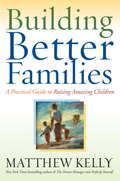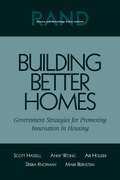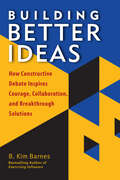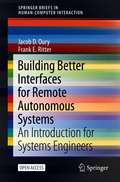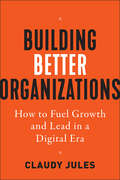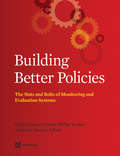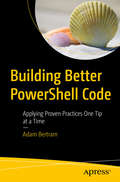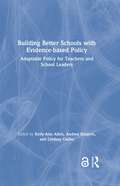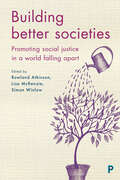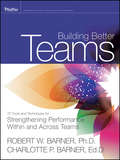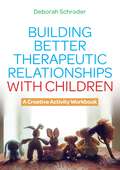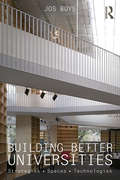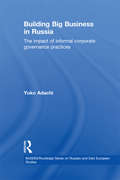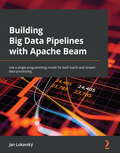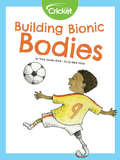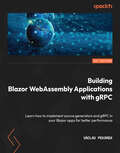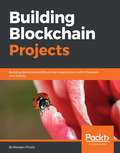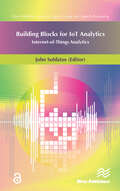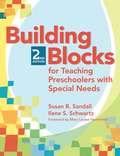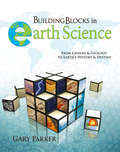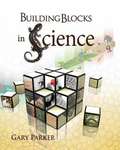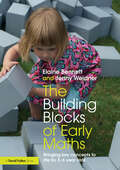- Table View
- List View
Building Better Families: A Practical Guide to Raising Amazing Children
by Matthew KellyFor more than a decade, Matthew Kelly has been traveling the world inspiring people to become the-best-version-of-themselves. During this time he has been amazed at how regularly he is asked: How do I encourage my children to embrace this message? How does your message apply to a family? Now, for the first time, Kelly shares with us remarkable insights and sensible everyday strategies for transforming the family into what it should be: a place where each of us can become the-best-version-of-ourselves. Beginning with an exploration of the changing face of the family in our culture, Kelly sets every reader at ease by explaining: "A family is not what we think a family should be, or what we hope to have, or should have, or what would be ideal-a family is what we actually have. A family is the one we've got. " Nor can a family ever be perfect, he goes on to explain. "Perfect families exist only in our minds, and it is these imaginings that are very often the enemy of our ability to enjoy the wonderful family we already have, or might have if we made it just that little bit more of a priority. " In Building Better Families, Kelly explores important issues by raising evocative questions: What makes a successful parent? Do you realize that your children are in the middle of a cultural war? What are the five things children really need? Are you asking your children the right questions? What are you teaching your children about work, money, food, exercise, body image, and sex? What are the priorities of your family culture? Every page of this book is filled with examples that can be applied to your daily experience of parenting and family, while at the same time illuminating the broader and deeper significance of family for society and the future of humanity. "The family is at once a deeply personal experience and the cornerstone of all great societies," Matthew Kelly tells us. Allow this book of classic wisdom and practical insight to help you build a better family. From the Hardcover edition.
Building Better Homes
by Ari Houser Debra Knopman Mark A. Bernstein Anny Wong Scott HassellThis report examines the structure, characteristics, and motivations of major participants in the housing industry to explore how innovation might be accelerated. It identifies options and strategies for the federal government to consider as it attempts to further advance innovation in housing to make homes more affordable, durable, and safe. Innovation in housing would provide benefits to a broad range of participants, including homebuilders, manufacturers, insurers, regulators, and homeowners.
Building Better Ideas: How Constructive Debate Inspires Courage, Collaboration and Breakthrough Solutions
by B. Kim BarnesWhy do teams settle for bad ideas or kill good ones? Popular consultant B. Kim Barnes's unique process of constructive debate shows how teams can create better ideas and outcomes by eliminating obstacles to honest discussion, creativity, and collaboration. In too many organizations, great ideas and unusual solutions can be suppressed, ignored, or attacked. Departments defend their turf, and people choose what is safe over what is better. Bad ideas move forward and good ideas die, which can lead to disastrous results—financial or otherwise. Luckily, there is a workable path out of this dysfunction. Kim Barnes's process of constructive debate shows how to establish conditions that encourage the free exchange, discussion, and development of ideas and eliminate conditions that prevent potentially useful ideas from getting heard. By using this tested model, any company or team can improve outcomes and bring out everyone's best ideas.A constructive debate is one in which a diverse group of individuals can express their ideas, engage others in building on and improving them, explore ideas deeply, and challenge one another's positions in a fair and productive way. In this book, you'll learn a set of behaviors you can model and encourage and a process you can facilitate, lead, or support your client in leading. In this time, where opinions can be tribal and differences can lead to unconstructive conflict, it's important to find ways to build robust ideas through a thoughtful, fair, and inclusive approach.
Building Better Interfaces for Remote Autonomous Systems: An Introduction for Systems Engineers (Human–Computer Interaction Series)
by Jacob D. Oury Frank E. RitterThis 'Open Access' SpringerBrief provides foundational knowledge for designing autonomous, asynchronous systems and explains aspects of users relevant to designing for these systems, introduces principles for user-centered design, and prepares readers for more advanced and specific readings. It provides context and the implications for design choices made during the design and development of the complex systems that are part of operation centers. As such, each chapter includes principles to summarize the design implication that engineers can use to inform their own design of interfaces for operation centers and similar systems. It includes example materials for the design of a fictitious system, which are referenced in the book and can be duplicated and extended for real systems. The design materials include a system overview, the system architecture, an example scenario, a stakeholder analysis, a task analysis, a description of the system and interface technology, and contextualized design guidelines. The guidelines can be specified because the user, the task, and the technology are well specified as an example.Building Better Interfaces for Remote Autonomous Systems is for working system engineers who are designing interfaces used in high throughput, high stake, operation centers (op centers) or control rooms, such as network operation centers (NOCs). Intended users will have a technical undergraduate degree (e.g., computer science) with little or no training in design, human sciences, or with human-centered iterative design methods and practices. Background research for the book was supplemented by interaction with the intended audience through a related project with L3Harris Technologies (formerly Harris Corporation).
Building Better Organizations: How to Fuel Growth and Lead in a Digital Era
by Claudy JulesThis essential playbook shows how companies can scale success by coupling digital strategies with an investment in the health of their organizations and the people within.To scale and grow, a company must get the organizational elements right. That begins with having the right strategy, the right leadership to drive it, and the right talent, culture, and organizational design to realize a company's potential. This is especially true in the AI era, where a company's most valuable assets are its people. To begin with, leaders must rethink their value creation strategies. To hone their organizational edge, leaders must prioritize their organization's health in seven vital areas: strategic direction, culture, leadership, talent, organizational design, EID (equity, inclusion, and diversity), and well-being. No matter what type or size of business, those essential conditions must be leveraged for increased value and growth. Put simply: organizational matters matter. To hone their digital edge, leaders must understand AI, as advances in technology allow leaders to build organizations that can compete and win in the future. Finally, an investor mindset will enable leaders to invest wisely in the technology (and leverage that tech) that sets their organizations apart.
Building Better Policies
by Keith Mackay Philipp Krause Gladys Lopez-AcevedoGovernments around the world face ongoing pressures from citizens to provide more and better services, and to do this while restraining taxation levels. This provides the context for government efforts to ensure their policies and programs are as effective, and as efficient, as possible. An emphasis on government performance has led a number of governments to create formal systems for monitoring and evaluating their performance--on a regular, planned, and systematic basis--with the objective of improving it. The focus of this book is on these government monitoring and evaluation (M and E) systems: what they comprise, how they are built and managed, and how they can be used to improve government performance.
Building Better PowerShell Code: Applying Proven Practices One Tip at a Time
by Adam BertramLearn to write better PowerShell code via short, example-driven tips. This book covers tips to make your PowerShell scripts faster and easier to read all while following proven best practices. Written by a six-time Microsoft MVP and one of the first Microsoft PowerShell MVPs with over a decade of PowerShell experience, Building Better PowerShell Code gives you easily digestible tips you can begin using immediately. The book starts with an overview of some of the most important tips the author can muster which segues into a deeper dive with dozens of examples throughout the book. It takes you through tips such as using community modules, writing better comments, thinking of PowerShell functions as building blocks, and more. You will also see how to use parameters the right way and how to create simple logging code to easily record script activity. You will learn not only how to write better code, but also how to implement some mindset tricks, such as being explicit and specific with code and how to write code that reads well. You’ll get into error handling and also how to make your scripts more secure. Finally, you’ll examine the concept of building PowerShell tools and how to build scripts for speed. Other tips and best practices include: Building Pester tests Improving performance through parallel processing Writing cross-platform scripts Using filtering properly After reading this book and applying these tips, you will have an expert coding mindset and be able to build PowerShell code that’s efficient, readable, and compliant with many best practices. What You Will Learn Implement error handling Create a logging function Use regular expressions to search strings Implement parallel processing Who This Book Is For PowerShell script developers.
Building Better Schools with Evidence-based Policy: Adaptable Policy for Teachers and School Leaders
by Kelly-Ann AllenBuilding Better Schools with Evidence-based Policy: Adaptable Policy for Teachers and School Leaders provides an extensive set of free-to-use policies for building better schools. The policies included in this book cover a broad range of popular topics for schools that are not readily accessible, and each policy is built on theory, driven by research, and created by experts. Each policy is based on substantial evidence, and this is ensured through the inclusion of contributors who are active and highly reputable in their respective field. Most schools are obliged to write and maintain policy, and not all school leaders have the required skills, time, or expertise to do this effectively. Building Better Schools with Evidence-based Policy: Adaptable Policy for Teachers and School Leaders is a time-saving resource for schools. It aims to address the reported research-to-practice gap in education by delivering accessible evidence-based practice in a ready-to-use adaptable format. All policies within this book are designed to be adapted and tailored to the unique diversity and needs of each school as reflected by the context and the people that make up the school community. This book is relevant to every person who works in a school – worldwide. Users of this book can rest assured that each policy has been carefully formulated from the current understandings of best practice. This is a practical innovation and an example of how schools can use research evidence in their day-to-day practices. "The Open Access version of this book is forthcoming and has been made available under a Creative Commons Attribution-Non Commercial-No Derivatives 4.0 license."
Building Better Societies: Promoting Social Justice in a World Falling Apart
by Rowland Atkinson, Lisa Mckenzie, Simon WinlowWhat would it take to make society better? For the majority, conditions are getting worse and this will continue unless strong action is taken. This book offers a wide range of expert contributors outlining what might help to make better societies and which mechanisms, interventions and evidence are needed when we think about a better society. The book looks at what is needed to prevent the proliferation of harm and the gradual collapse of civil society. It argues that social scientists need to cast aside their commitment to the established order and its ideological support systems, look ahead at the likely outcomes of various interventions and move to the forefront of informed political debate. Providing practical steps and policy programmes, this is ideal for academics and students across a wide range of social science fields and those interested in social inequality.
Building Better Teams
by Robert Barner Charlotte P. BarnerOver the past 10 years in the field of human and organizational development, the approach to team building has moved from problem solving and conflict management to helping work groups and organizations build a foundation of trust, cooperation, and mutual support. Focusing on collaboration rather than resolving conflict, Building Better Teams: 70 Tools and Techniques for Strengthening Performance Within and Across Teams offers a fresh approach to team building. It provides proven tools for the most common needs of teams, including establishing trust, building consensus, managing change, working virtually and across boundaries, and dealing with setbacks.
Building Better Therapeutic Relationships with Children: A Creative Activity Workbook
by Deborah SchroderThis easy-to-use workbook filled with ideas and activities is essential for therapists, counselors and mental health professionals for starting, developing and sustaining strong therapeutic relationships with children. Focussing on creating a partnership in the therapy room, chapters include practical guidance on the difference between relationship building between adults and children, adapting activities to a variety of settings and starting the relationship. Resolve a variety of challenges in the therapeutic relationship faced by those working with children and families such as, anger, anxiety, reticence, problems with separation and change and saying goodbye. Introducing creativity into the work, these exercises will integrate seamlessly into your practice every day.
Building Better Universities: Strategies, Spaces, Technologies
by Jos BoysBuilding Better Universities provides a wide-ranging summary and critical review of the increasing number of groundbreaking initiatives undertaken by universities and colleges around the world. It suggests that we have reached a key moment for the higher education sector in which the services, location, scale, ownership, and distinctiveness of education are being altered dramatically, whether universities and colleges want it or not. These shifts are affecting traditional assumptions about both the future ‘shape’ of higher education institutions, and the roles of—and relationships between—learners, teachers, researchers, managers, businesses, communities and other stakeholders. Building Better Universities aims to bridge the gap between educational ideas about what the university is, or should be ‘for’, and its day-to-day practices and organisation. It roams across strategic, operational, and institutional issues; space planning and building design; and technological change, in order to bring together issues that are often dealt with separately. By analysing the many challenges faced by higher education in the contemporary period, and exploring the various ways universities and colleges are responding, this powerful book aims to support a ‘step-change’ in debates over the future of higher education, and to enable senior managers and faculty to develop more strategic and creative ways of enabling effective twenty-first-century learning in their own institutions.
Building Big Business in Russia: The Impact of Informal Corporate Governance Practices (BASEES/Routledge Series on Russian and East European Studies)
by Yuko AdachiThis book examines the development of big business in Russia since the onset of market oriented reform in the early 1990s. It explains how privatized post-Soviet enterprises, many of which made little sense as business units, were transformed into functional firms able to operate in the environment of a market economy. It provides detailed case studies of three key companies – Yukos Oil Company, Siberian (Russian) Aluminium and Norilsk Nickel – all of which played a key role in Russia’s economic recovery after 1998, describing how these companies were created, run and have developed. It shows how Russian businesses during the 1990s routinely relied on practices not entirely compatible with formal rules, in particular in the area of corporate governance. The book fully explores the critical role played by informal corporate governance practices - such as share dilution, transfer pricing, asset stripping, limiting shareholders access to votes, and 'bankruptcy to order’ - as Russian big business developed during the 1990s. Unlike other studies on Russian corporate governance, this book highlights the ambiguous impact of informal corporate governance practices on the companies involved as commercial entities, and suggests that although their use proved costly to Russia’s business reputation, they helped core groups of owners/managers at the time to establish coherent business firms. Overall, the book shows that we cannot understand the nature of current economic changes in Russia without recognising the crucial role played by informal corporate governance practices in the creation and development of big business in post-Soviet Russia.
Building Big Data Pipelines with Apache Beam: Use a single programming model for both batch and stream data processing
by Jan LukavskyImplement, run, operate, and test data processing pipelines using Apache BeamKey FeaturesUnderstand how to improve usability and productivity when implementing Beam pipelinesLearn how to use stateful processing to implement complex use cases using Apache BeamImplement, test, and run Apache Beam pipelines with the help of expert tips and techniquesBook DescriptionApache Beam is an open source unified programming model for implementing and executing data processing pipelines, including Extract, Transform, and Load (ETL), batch, and stream processing.This book will help you to confidently build data processing pipelines with Apache Beam. You'll start with an overview of Apache Beam and understand how to use it to implement basic pipelines. You'll also learn how to test and run the pipelines efficiently. As you progress, you'll explore how to structure your code for reusability and also use various Domain Specific Languages (DSLs). Later chapters will show you how to use schemas and query your data using (streaming) SQL. Finally, you'll understand advanced Apache Beam concepts, such as implementing your own I/O connectors.By the end of this book, you'll have gained a deep understanding of the Apache Beam model and be able to apply it to solve problems.What you will learnUnderstand the core concepts and architecture of Apache BeamImplement stateless and stateful data processing pipelinesUse state and timers for processing real-time event processingStructure your code for reusabilityUse streaming SQL to process real-time data for increasing productivity and data accessibilityRun a pipeline using a portable runner and implement data processing using the Apache Beam Python SDKImplement Apache Beam I/O connectors using the Splittable DoFn APIWho this book is forThis book is for data engineers, data scientists, and data analysts who want to learn how Apache Beam works. Intermediate-level knowledge of the Java programming language is assumed.
Building Bionic Bodies
by Tracy Vonder Brink Mark HicksDo you know someone who has a prosthetic? Many people that you might see have prosthetics and you cannot even tell! In fact, people have created and used prosthetics for thousands of years! This story shows how prosthetics have changed over time in the way they have been created and allowed mobility. You will also learn how technology has allowed prosthetics to help even more people in ways than they ever have before. Prosthetics help people to walk and run, hear, eat, and to even help them stay alive! Some may say that important pieces of technology have allowed people to become "bionic!"
Building Blazor WebAssembly Applications with gRPC: Learn how to implement source generators and gRPC in your Blazor apps for better performance
by Vaclav PekarekExplore the power of Blazor WebAssembly, gRPC, and source generators for easy and quick web developmentKey FeaturesGet to grips with integration between Blazor, gRPC, and source generators in real-life projectsDevelop a complete Blazor WebAssembly project that takes advantage of gRPC's capabilitiesExplore best practices for building a high-performance web application with Blazor and C#Book DescriptionBuilding Blazor WebAssembly Applications with gRPC will take you to the next level in your web development career. After working through all the essentials of gRPC, Blazor, and source generators, you will be far from a beginner C# developer and would qualify as a developer with intermediate knowledge of the Blazor ecosystem.After a quick primer on the basics of Blazor technology, REST, gRPC, and source generators, you'll dive straight into building Blazor WASM applications. You'll learn about everything from two-way bindings and Razor syntax to project setup. The practical emphasis continues throughout the book as you steam through creating data repositories, working with REST, and building and registering gRPC services. The chapters also cover how to manage source generators, C# and debugging best practices, and more. There is no shorter path than this book to solidify your gRPC-enabled web development knowledge.By the end of this book, your knowledge of building Blazor applications with one of the most modern and powerful frameworks around will equip you with a highly sought-after skill set that you can leverage in the best way possible.What you will learnMaster routing and test your learning with demo applicationsCreate service and controller classes for your API endpointsUse gRPC with Blazor instead of REST and revamp your applicationsStudy partial classes, attributes, and more in source generatorsWrite reusable Razor components and debug your code effectivelyUnderstand the semantic model of C# codeDiscover how to read and navigate through syntax treesBuild dynamic websites without using JavaScriptWho this book is forThis book is for beginner C# developers who want to learn how to create more performant web apps with less code using Blazor, the gRPC protocol, and source generators. The book assumes a basic understanding of C#, HTML, and web development concepts.
Building Blockbuster Products and Services: Employ an Entrepreneurial Mindset
by Ian Macmillan Rita Gunther McgrathThe current business environment is tumultuous and full of uncertainty. What you need is an entrepreneurial mindset--a way of thinking about your business that captures the benefits of uncertainty. A key aspect of establishing an entrepreneurial mindset is creating the conditions under which everyone is energized to look for opportunities to change the current business model. The simplest way to change your business model is to redesign your products and services in ways that will be supremely appealing to your customers and highly profitable for your firm. This chapter shows you how. This chapter is excerpted from "The Entrepreneurial Mindset: Strategies for Continuously Creating Opportunity in an Age of Uncertainty."
Building Blockchain Projects
by Narayan PrustyThis book is for JavaScript developers who now want to create tamper-proof data (and transaction) applications using Blockchain and Ethereum. Those who are interested in cryptocurrencies and the logic and database empowering it will find this book extremely useful.
Building Blocks: Foundations for Learning for Young Blind and Visually Impaired Children
by Betty Dominguez Joe DominguezThis bilingual (English/Spanish) book comprises six chapters each of Part I & II on Early Learning and Blind and Visually Impaired Children and on Activities for Blind and Visually Impaired Preschoolers.
Building Blocks for IoT Analytics Internet-of-Things Analytics
by John SoldatosInternet-of-Things (IoT) Analytics are an integral element of most IoT applications, as it provides the means to extract knowledge, drive actuation services and optimize decision making. IoT analytics will be a major contributor to IoT business value in the coming years, as it will enable organizations to process and fully leverage large amounts of IoT data, which are nowadays largely underutilized. The Building Blocks of IoT Analytics is devoted to the presentation the main technology building blocks that comprise advanced IoT analytics systems. It introduces IoT analytics as a special case of BigData analytics and accordingly presents leading edge technologies that can be deployed in order to successfully confront the main challenges of IoT analytics applications. Special emphasis is paid in the presentation of technologies for IoT streaming and semantic interoperability across diverse IoT streams. Furthermore, the role of cloud computing and BigData technologies in IoT analytics are presented, along with practical tools for implementing, deploying and operating non-trivial IoT applications. Along with the main building blocks of IoT analytics systems and applications, the book presents a series of practical applications, which illustrate the use of these technologies in the scope of pragmatic applications. Technical topics discussed in the book include: Cloud Computing and BigData for IoT analyticsSearching the Internet of ThingsDevelopment Tools for IoT Analytics ApplicationsIoT Analytics-as-a-ServiceSemantic Modelling and Reasoning for IoT AnalyticsIoT analytics for Smart BuildingsIoT analytics for Smart CitiesOperationalization of IoT analyticsEthical aspects of IoT analyticsThis book contains both research oriented and applied articles on IoT analytics, including several articles reflecting work undertaken in the scope of recent European Commission funded projects in the scope of the FP7 and H2020 programmes. These articles present results of these projects on IoT analytics platforms and applications. Even though several articles have been contributed by different authors, they are structured in a well thought order that facilitates the reader either to follow the evolution of the book or to focus on specific topics depending on his/her background and interest in IoT and IoT analytics technologies. The compilation of these articles in this edited volume has been largely motivated by the close collaboration of the co-authors in the scope of working groups and IoT events organized by the Internet-of-Things Research Cluster (IERC), which is currently a part of EU's Alliance for Internet of Things Innovation (AIOTI).
Building Blocks For Teaching Preschoolers With Special Needs (Second Edition)
by Susan R. Sandall Ilene S. Schwartz Gail E. Joseph Eva M. Horn Samuel L. Odom Mary Louise HemmeterUpdated for today's educators--especially those new to inclusion--the second edition of this bestselling guide is the lifeline preschool teachers need to fully include children with disabilities in their classrooms. Easy to use with any existing curriculum, including Creative Curriculum and HighScope, Building Blocks gives educators three types of practical, research-based inclusion strategies that promote progress in critical areas like behavior, emergent literacy, and peer relationships. A must for professional development, this revised edition helps teachers thrive in the era of accountability with NEW material that reflects the six years of changes in early education since the first edition. Teachers will discover how the Building Blocks approach aligns with OSEP outcomes to help teachers meet the federal requirements for special education learn everything they need to know about evidence-based practice and how to apply it in their classrooms. Through clear and instructive vignettes woven throughout the book, teachers will also meet four young children from diverse backgrounds and learn from their teachers' examples of successful interventions. A perfect training tool for teachers and an ideal textbook for college and university courses, this revised bestseller will help today's preschool educators start all their students on the road to lasting school success. Promote inclusion and improve child outcomes through curriculum modifications that allow all children to participate embedded learning opportunities used in typical classroom activities child-focused instructional strategies that help students with individual learning objectives
Building Blocks in Earth Science
by Dr Gary ParkerDevelop critical thinking skills as you explore what to believe and why you believe it! To understand earth science, it requires "teamwork," combining the methods and evidences of both science and history. And if you also use the "history book of the world," the Bible, you can make sense of the Earth's surface -- altered, formed, and weathered over time, the landscapes and vistas we enjoy today. Learn about the: Structure of the Earth and its atmosphere. Types of minerals and rocks, the water table, and types of volcanoes Earth's tornadoes, faults, polarity, magnetism, reeds, folding, hypercanes, deltas, and much more! When you understand the difference in history and science in questions related to our planet, you can more effectively discern the evidences seen in the world around you. Science is an awesome tool for understanding the workings of our world and for applying such knowledge to benefit mankind. "Scientific truth" however is not determined by consensus, compromise, majority vote, popularity, celebrity endorsement, money, media endorsement, or best-selling books -- and it is at its best when it is rooted in a worldview that begins with the Bible!
Building Blocks In Earth Science: From Genesis And Geology To Earth's History And Destiny
by Gary ParkerDevelop critical thinking skills as you explore what to believe and why you believe it! To understand earth science, it requires “teamwork,” combining the methods and evidences of both science and history. And if you also use the “history book of the world,” the Bible, you can make sense of the Earth’s surface — altered, formed, and weathered over time, the landscapes and vistas we enjoy today. Learn about the: - Structure of the Earth and its atmosphere. - Types of minerals and rocks, the water table, and types of volcanoes - Earth's tornadoes, faults, polarity, magnetism, reeds, folding, hypercanes, deltas, and much more! When you understand the difference in history and science in questions related to our planet, you can more effectively discern the evidences seen in the world around you. Science is an awesome tool for understanding the workings of our world and for applying such knowledge to benefit mankind. “Scientific truth” however is not determined by consensus, compromise, majority vote, popularity, celebrity endorsement, money, media endorsement, or best-selling books — and it is at its best when it is rooted in a worldview
Building Blocks in Science
by Dr Gary ParkerHave you ever wondered about human fossils, "cave men", skin color, "ape-men", or why missing links are still missing? Want to discover when T. Rexwas small enough to fit in your hand? Or how old dinosaur fossils are - and how we know the age of these bones? Learn how the Bible's world view (not evolution's) unites evidence from science and history into a solid creation foundation for understanding the origin, history, and destiny of life - including yours! Start reinforcing a strong foundation for learning with study questions, discussions, discussion topics, and more for home and school educators! In this fascinating book, Gary Parker explores some of the most interesting areas of science: fossils, the errors of evolution, the evidence of creation, all about early man and human origins, dinosaurs, and even "races." Learn how scientists use evidence in the present, how historians use evidence of the past, and discover the biblical world view, not evolution, that puts the two together in a credible and scientifically-sound way! Having made his own journey of discovery, this former evolutionary biologist and popular author offers a unique and powerful perspective on the science of our world - past and present. Build your world view on a faith that fits the scientific facts!
The Building Blocks of Early Maths: Bringing key concepts to life for 3-6 year olds
by Elaine Bennett Jenny WeidnerYoung children need to develop and understand the core basic concepts in mathematics before they can move forward in their mathematical learning. Without these solid foundations, they are more likely to have gaps in their knowledge and require intervention in their primary years. This new book provides guidance and resources to help you develop children’s key skills and understanding in mathematics. Written by experienced teachers, the book outlines key mathematical concepts and provides a wide range of exciting, mathematically rich activities that support the development of these concepts. It exposes some of the common misconceptions and errors that practitioners may observe children showing in their settings and offers simple practical strategies to help move children forward in their thinking and understanding. Covering all areas of mathematics learning – counting and number, calculation, shape and space, pattern, measuring and handling data – the book features: practical ideas for supporting assessment, observation, mathematical vocabulary and building links with home activities that promote a child-led approach, linked to children‘s everyday lives and experiences guidance on how to extend and challenge children’s learning through adult-led, quality teaching and effective practice a clear sense of progression based on children’s understanding rather than age. Written by experienced practitioners, The Building Blocks of Early Maths will help you to ensure that the children in your care have the strong foundations they need to become confident successful mathematician in the future.
